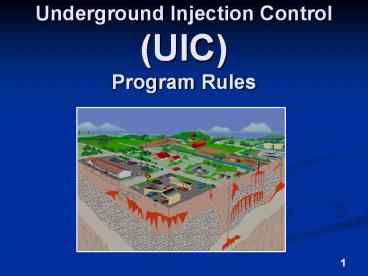Underground Injection Control (UIC) Program Rules - PowerPoint PPT Presentation
1 / 18
Title:
Underground Injection Control (UIC) Program Rules
Description:
Manage Stormwater Dispose of sanitary waste Dispose of commercial and industrial waste fluids Enhance remediation at ground water clean up sites Advisory ... – PowerPoint PPT presentation
Number of Views:87
Avg rating:3.0/5.0
Title: Underground Injection Control (UIC) Program Rules
1
Underground Injection Control (UIC) Program
Rules
2
What is the UIC Program?
- The UIC Program is part of the Safe Drinking
Water Act. - The goal of the UIC program is to protect ground
water for drinking by regulating discharges to
UIC wells. - Federal regulations describe the UIC Program
requirements for states to follow.
3
UIC Program in Washington
- Ecology began administering the UIC Program in
1984. It was part of the larger package to gain
primacy for the NPDES Program. - Majority of UIC wells are NOT under a permit, but
are registered and authorized through the
regulation. - Some WA counties use thousands of UIC wells to
manage stormwater Spokane, Yakima, Clark,
Pierce, and Tri Cities area.
4
Why are we proposing to change the UIC rules?
- The UIC rule was opened up because EPA revised
their regulation. If Ecology wants to continue
administering the program we have to update our
regulation - UIC Program Rules, Chapter 173-218 WAC
- State Waste Discharge Program Rules, Ch 173-216
WAC (minor change to allow UIC wells in permit,
if needed).
5
What is a UIC well?
- A UIC well is a man made structure used to
discharge fluids into the ground. - It has to be deeper than wide at the land surface
or a subsurface distribution system or an
improved sinkhole.
6
What types of UIC wells are there?
- There are 5 Classes of UIC wells defined by
USEPA . Many of the first 4 classes are banned or
restricted. - Class 5 wells are the most common method of
discharging water to the subsurface. - In Washington, the majority of UIC wells are
Class 5 wells. Examples are dry wells, french
drains, drainfields, boreholes, and infiltration
trenches with perforated pipe.
7
In WA UIC wells are used to
- Manage Stormwater
- Dispose of sanitary waste
- Dispose of commercial and industrial waste fluids
- Enhance remediation at ground water clean up
sites
8
What do I have to do if I own or manage a UIC
well?
- Meet the 2 federal requirements
- 1. All UIC wells must be registered and
- 2. Meet the non-endangerment standard.
- If the above can not be met, a permit will be
needed to operate the well. - NOTE Ecology believes most UIC wells will not
need a permit.
9
1. Registration
- UIC wells must be registered with Ecology or EPA.
- Registration forms are available from Ecology.
- NOTE UIC wells used at single family homes are
exempt from registering
10
2. Meeting the non-endangerment standard
EXISTING Stormwater
- EXISTING UIC wells used for stormwater management
can be grandfathered in if the owner - Registers the wells
- Completes a well assessment and
- Retrofit UIC wells, is necessary
11
Meeting the non-endangerment standardNEW
Stormwater
- NEW UIC wells used for stormwater management
- The owner can use the approaches in the
stormwater manuals or an approved manual OR show
the site practices will be protective.
12
Meeting the non-endangerment standardOther UIC
Wells
- Other UIC wells not used for stormwater, must
- Existing - grandfathered in if already
registered, meet new requirements if not
registered - New - meet new well requirements
13
What is a well assessment?
- Evaluates the potential risks to ground water
from the use of UIC wells. - Identifies UIC wells that are a high threat to
ground water - Includes a schedule for the wells that are
determined to be a high threat and need to be
retrofitted.
14
Other proposed rule changes
- Federal ban of 2 types of UIC wells motor
vehicle waste disposal wells and large capacity
cesspools - Lists Class V wells that automatically meet the
non-endangerment standard (protective standard) - Decommissioning (Closure) standards for all UIC
wells.
15
What have we done so far in the UIC rule revision
process?
- Nov 2001 - Filed the CR101, initial notice
letting the public know we are considering
changes to the rules. - 2002-2004 A UIC rule revision committee was
formed, based largely on participants who took
part in the Eastern WA stormwater manual.
Assisted in drafting the revisions. - Nov 2004 - Held informational public workshops on
rule revisions.
16
Rule Revision Timeline
November, 2004
June 2005
Feb 2006
2002 2004
Advisory Committee Meetings
Informational Workshops
FormalRule Process begins
File Final Rule
Public Comment Period
17
What will be in the UIC Rule Package for public
comment?
- Draft UIC Rule
- Draft Technical guidance for UIC wells used for
stormwater management - Draft Implementation Plan
- Small Business Economic Impact Analysis
- Cost Benefit Analysis
18
To summarize
- Majority of UIC wells will not need a permit.
- Rule requirements are register all UIC wells and
meet the non-endangerment standard. - New stormwater management wells use best
management practices to meet requirement. - Existing stormwater management wells are
grandfathered in unless they cause or contribute
to a water quality problem. - Non stormwater managed wells are either
grandfathered in (registered) or must meet the
requirements for new wells (not registered).































